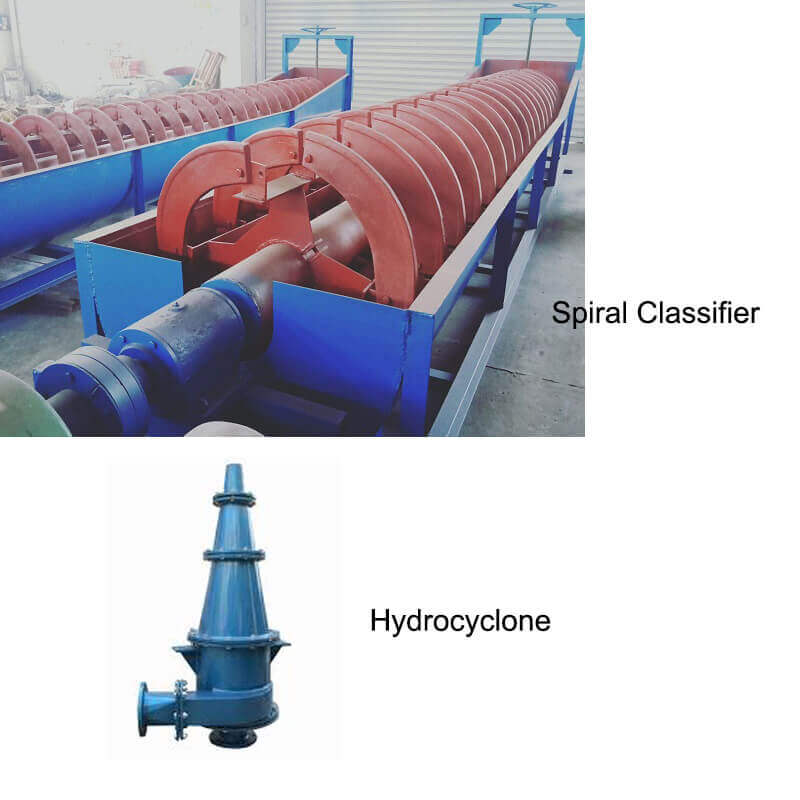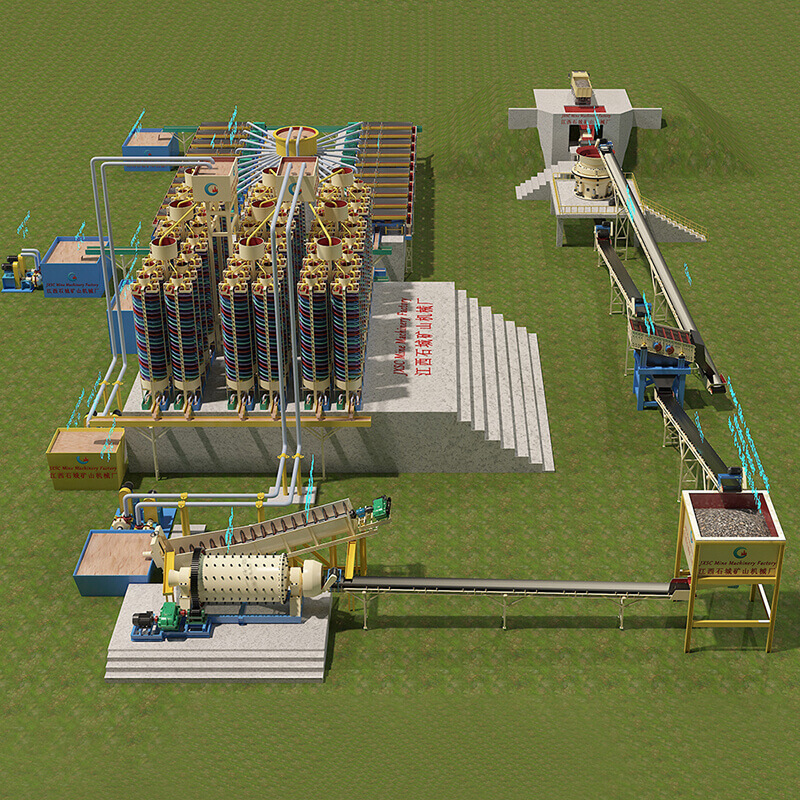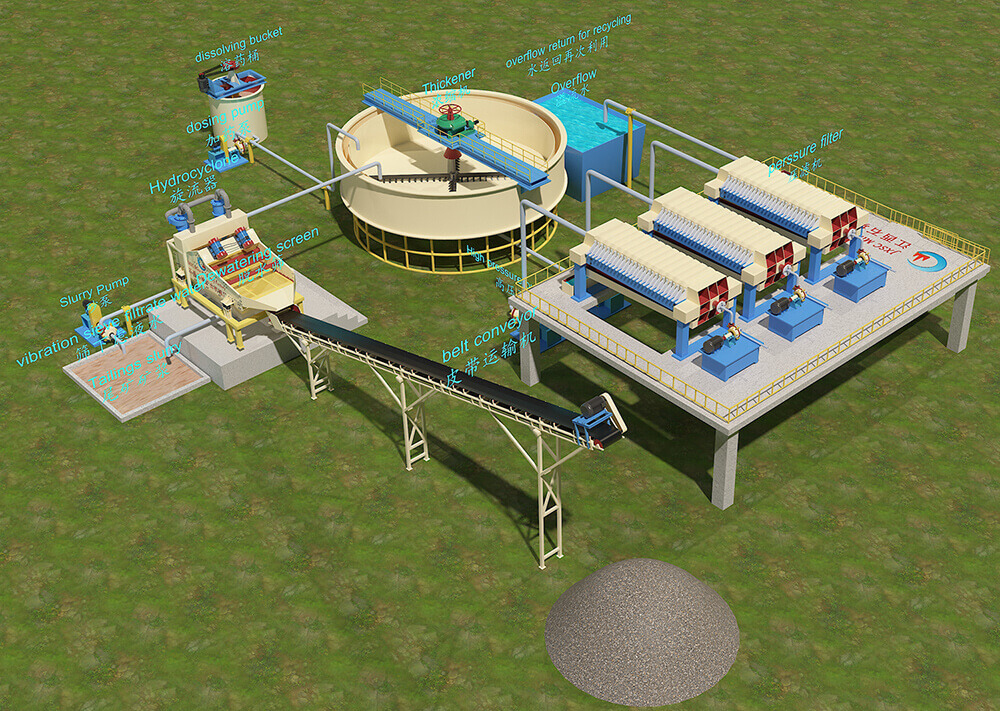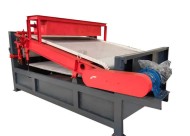In the beneficiation process, the purpose of the classification operation is to separate the coarse and fine particles effectively, avoid the over-crushing of the fine-grained minerals, and simultaneously make the coarse-grained minerals return to the mill for regrinding. The operation effect will directly affect the production capacity of the grinding equipment, the finished product effect, and the concentrate grade and recovery rate in subsequent sorting operations.
Spiral classifiers and hydrocyclones are commonly used classification equipment in two mineral processing plants. Before deciding which grading equipment to use, we must be clear about the difference between the two and then make a targeted choice.
Spiral Classifier VS Hydrocyclone
Applicable Materials With Different Particle Sizes
The typical spiral classifiers include high weir type and submerged type. Among them, the high-weir spiral classifier is usually used for coarse-grained classification, and its classification overflow particle size diameter is generally greater than 0.15mm. The submerged spiral classifier is suitable for fine particle classification, and the overflow particle size of the classification is usually less than 0.15mm.
Compared with these two spiral classifiers, the hydrocyclone has a significantly better classification effect when dealing with finer-grained materials (the separation particle size range is generally 0.3-0.01mm).
Different Classification Efficiencies
Generally, hydro cyclones’ classification efficiency and product accuracy are lower than the spiral classifiers. A large part of the reason is that hydro cyclones will change the position of the final material discharge when the pressure is not up to standard.
The spiral classifier rotates at a low speed through the spiral to stir the pulp to make the fine particles suspend to the top and overflow to the overflow weir. In contrast, the coarse particles sink to the bottom of the tank and are conveyed to the discharge port by the screw to be discharged as returned sand, while The hydrocyclone needs to be discharged on the side opposite to the feed inlet. Once the pressure is not up to the standard, the stratification of the material will be disordered, failing the material to be discharged from the discharge port normally. But this is not absolute. When the grading particle size is very fine (such as 0.037mm), the grading efficiency of the hydrocyclone is higher than that of other grading equipment.
Different Floor Space
The footprint of a hydrocyclone is significantly smaller than that of a spiral classifier. Usually, the hydrocyclone occupies only 1/30-1/50 of the spiral classifier. The equipment footprint requirements limit the application of spiral classifiers to some extent.
Different Daily Operation Requirements
The spiral classifier is simple in structure, stable and easy to operate. It is also because of its simple operation process and stable working status, which not only greatly reduces the cost of maintenance and replacement but also guarantees the construction time and makes the grading operation more secure. The operation of the hydrocyclone is more complicated, and the ore pressure, concentration, and particle size will all affect its classification index, so the operation accuracy is required to be higher.
Different Equipment Investment Costs
In terms of equipment investment, the price of the hydrocyclone is lower than that of the spiral classifier. In addition to its equipment, the hydrocyclone also needs a series of necessary auxiliary equipment in the grading process, such as distributors, valves, pumps, etc., which increases a part of equipment investment accordingly.
In terms of equipment maintenance, the worn parts of the hydrocyclone are mainly the lining and the overflow pipe. The frequency and degree of wear are caused by material particle size, shape, and solid content. Therefore, the actual dressing plant practice can only accurately obtain its service life and maintenance cost. The maintenance of the spiral classifier is mainly to replace the spiral lining tile and other daily maintenance.
Generally speaking, the equipment investment cost of the spiral classifier is higher than that of the hydrocyclone.
The classifier equipment cooperates with the ore grinding equipment in the beneficiation production line to jointly provide ore (material) with suitable particle sizes for the beneficiation operation. The choice of beneficiation equipment will not be decided unilaterally but must result from comprehensive consideration. In production, it is recommended that you choose single or multiple grading equipment according to the relevant equipment selection given by the beneficiation test to achieve the ideal grading effect.
JXSC Spiral Classifier Application
Rock Chrome Ore Processing Plant
This Setup is a Rock Chrome ore processing plant. It is configured with raw material feeding, primary crushing, fine crushing, screening, ball mill grinding, and gravity separation to separate and upgrade Chrome concentrate.
The chrome ore raw material stone is fed to the primary jaw crusher by a vibration feeder to feed rock chrome ore smoothly and evenly. The vibration feeder is with the grizzly bar to grizzly oversize to a primary jaw crusher. Under the grizzly bar small-size material go to the fine crusher by conveyor. So as can increase the crushing effect of the primary jaw crusher.
The primary jaw crusher is for crushing big rock chrome ore to a smaller size, output material to go next fine crushing machine cone crusher. The cone crusher is crushed rock chrome to below 20mm suitable for feeding to the ball mill but firstly will first go to a vibration screen for screening out oversize+20mm and sent back to cone crush crushing again. Under screen 0-20mm go to storage bin before ball mill. If a small capacity plant, the cone crusher can be replaced by another type of fine crusher, such as a fine jaw crusher, hammer crusher, impact fine crusher, etc.
An electromagnetic vibration feeder and belt conveyor will send the 0-20mm powder material to the ball mill smoothly. The ball mill is for grinding 0-20mm to small powder. It works with the spiral classifier, so the overflow slurry from the classifier is about 80% 200mesh powder. The oversize particle from the classifier will go back to ball mill grinding again, to form a closed-loop.
The 200mesh slurry will be pumped to a gravity separation machine, spiral chute, and shaking table. The spiral chute is for primary concentration. To increase the Chrome recovery ratio to the maximum, we use a 2-stage spiral chute separation. The middling material from the 1st stage spiral chute group will be pumped to the 2nd stage spiral group to recover as much chrome as possible.
All the heavy concentrate ore discharged from the two stages of the spiral group will go to the shaking table for concentrate again, to get higher-grade chrome concentrate.
This setup plant design can be customized according to the customer’s chrome ore conditions. If you need a much higher-grade chrome concentrate, consider adding a high-intensity magnetic separator at the final stage.
The plant capacity can also be as requested, such as 2tph,5tph,10tph,15tph,20tph, or bigger.
JXSC Hydrocyclone Application
200 TPH Dry Tailings Processing Plant
This setup is a 200-ton-per-hour dry tailing processing plant. The main configuration including
Dewatering screen with hydrocyclone, thickener, dissolving tank, filter press, belt conveyor, and related pumps.
The process is as below:
- The tailings slurry pump to the hydrocyclone of the dewatering screen, and the underflow goes to the screen for dewatering. A belt conveyor transfers the oversize product away; the vibration sieve filtrates water and goes to the tailings slurry pool as a closed circle.
- The overflow of the hydrocyclone goes to the thickener for precipitation.
- At the same time, a flocculant will be added to the thickener. The flocculant will first be put into a dissolving tank and pumped into the thickener by a dosing pump.
- The overflow from the thickener for recycling; the underflow from the thickener goes to the filter press.
- The filter press for filtering, the water can be re-used, the solid is dry enough and can transfer away by belt, etc.
The capacity can be customized as per request such as 10tph, 50tph,50tph, etc
LATEST PRODUCTS
Tubular Screw Conveyor
【Capacity】6-50 m3/h【Procesible Material】 …
Heavy Plate Feeder
Capacity: 100-240 m3/h Power: 15-45 kW Speed: 0…
Plate Magnetic Separator
【Capacity】8-35 t/h 【Power】1.5-3 kW 【Applic…












